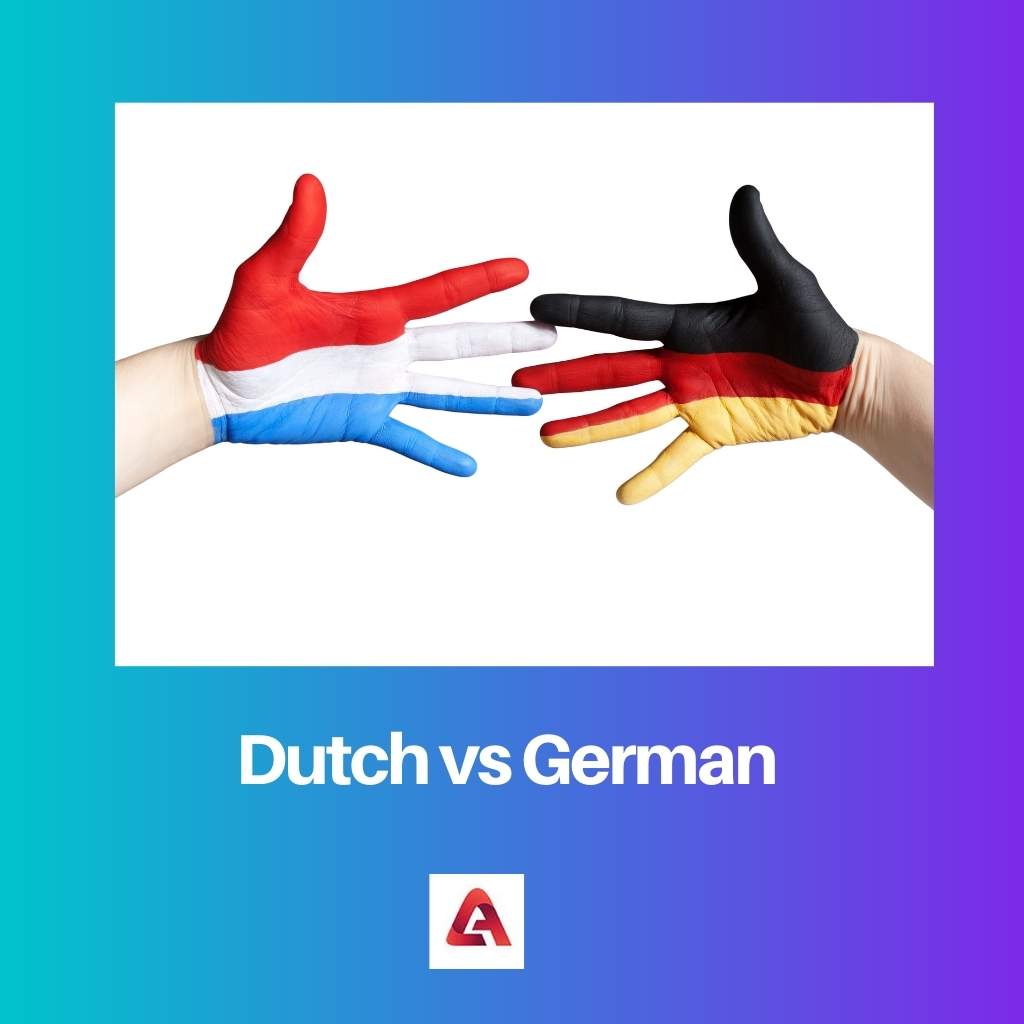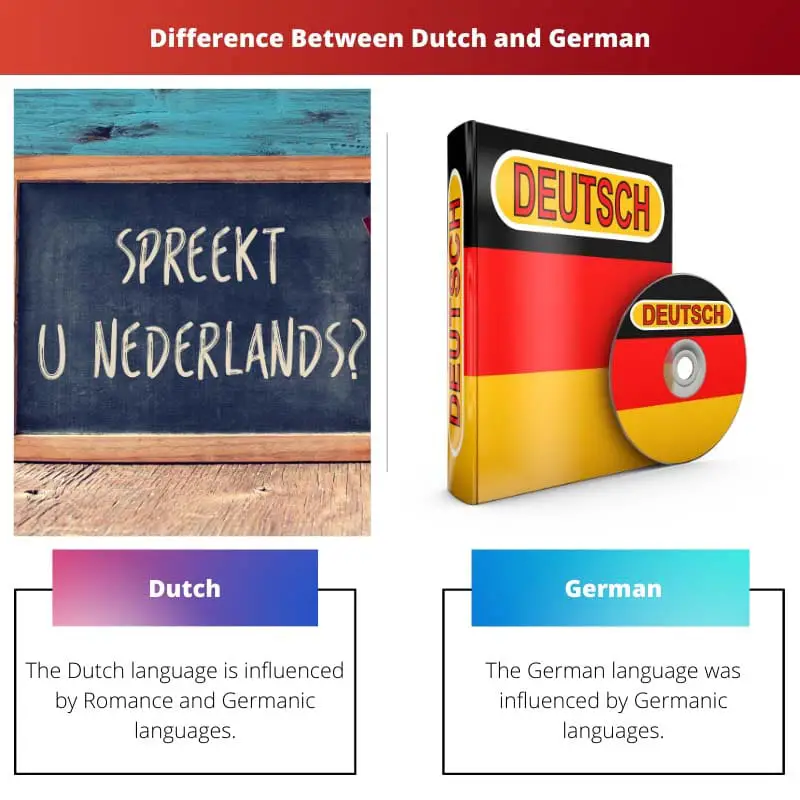In today’s world, we communicate with each other in a certain language. Language can be considered an important tool for defining nationality. Every nation has its language, but sometimes one language can be an official language for several countries.
Each language belongs to a huge language branch which is further divided into many parts. Dutch and German are two of them which belong to West Germanic languages and are part of Indo-European languages.
Key Takeaways
- Dutch and German are Germanic languages but have distinct vocabulary, pronunciation, and grammar differences.
- Dutch uses more loanwords from English and has a simpler grammar structure than German.
- German has more regional dialects and is spoken by a larger population than Dutch.
Dutch vs German
The difference between Dutch and German is that Dutch has no case, which makes it easier to learn, whereas German has 4 cases which makes it quite difficult. This difference is because Dutch has evolved from a simpler grammar structure. When it comes to grammar, they both differ from each other in many terms, such as articles, nouns, adjectives, etc.

The Dutch language is spoken by 23 million people as their first language worldwide. It is majorly spoken in Netherlands and Belgium. It is also the official language of St Maarten, Aruba, and Curacao.
Dutch Language Union, or Nederlandse Taalunie, is a platform whose main objective is to cooperate on issues of the Dutch language. The German language is spoken by 100 million people all over the world. It ranks in sixth number among the languages worldwide.
Germany is the official language of Germany, Switzerland, Luxemburg, Austria, Liechtenstein, parts of Italy, and Belgium. German ranks among the top five languages which are used on the internet.
Comparison Table
| Parameters of comparison | Dutch | German |
|---|---|---|
| Influenced by | Romance and Germanic languages | Germanic languages |
| Location | Spoken in Belgium and Netherlands | Spoken in Germany, Switzerland, Austria, Liechtenstein, and South Tyrol |
| Regulation | Regulated by Nederlandse Taalunie | Not regulated officially |
| Case system | No | 4 cases |
| Popularity | Not popular as German | Most popular language across the world |
What is Dutch?
Romance and Germanic languages influence the Dutch language, and later this language gave rise to other Creole languages such as Afrikaans. This language belongs to the West Germanic sub-group.
The Dutch language has dominant characteristics of Ingvaeonic, which consistently occurs in English and Frisian. It has not been wholly influenced by the south to the north movement led by the High German consonant shift and has its changes.
Dutch originated from the dialects of Old Frankish. From the language tree, the Indo-European language is one of the branches which is further divided into Germanic languages. So, it can be seen that it portions with languages such as German, Scandinavian and English languages.
In terms of grammar, it has plural forms, rules, and words that are easy to learn, such as -s or -en. It has only two genders, common (feminine and masculine) and neuter (objects without gender).
The order of verbs is much like English. In Dutch, cases are not required with nouns, adjectives, or articles, and “de” or “het” are only used with them. Dutch is a West Germanic language which is the third most spoken Germanic language.
It is mainly native to the Netherlands (official language countrywide) and Belgium (one of three official languages). For 24 million people, Dutch is their first language, while for 5 million people, it is their second language.

What is German?
The German language was influenced by Germanic languages. It is similar to other languages which are included in the branch of the West Germanic language.
This language belongs to the West Germanic sub-group, which has the dominant characteristics of Erminonic. It has been mainly developed from two stages Old High German and Middle High German.
When it comes to dialect, it is still so different in the contemporary world. In World War II, German-Swiss wanted to choose a dialect for speaking over the standard German.
Switzerland announced Standard German as their official language, and this Swiss dialect of German is hard to understand by Swiss who do not speak German and native speakers of Germany.
In terms of grammar, German has irregular and varied plurals, which makes it difficult to learn. It has a total of three genders such as feminine, masculine, and neuter.
In German, the usage of verbs is completely reversed, such as present tense is used instead of future tense. It also has a complete table to apply cases such as “den, die, das”.
The German language is also considered a West Germanic language, which is the second most spoken Germanic language. This language is dominant in Central Europe.
The German language is majorly spoken in Germany, Switzerland, Austria, Liechtenstein, and South Tyrol. It is one of the most popular languages in the world. For 95 million people, German is their first language, while for 85 million people, it is their second language.

Main Differences Between Dutch and German
- Capital letters in the Dutch language mainly follow the rules which are applied in English with some exceptions. On the other hand, every noun is capitalized in German.
- In Dutch, a word never ends with two similar letters, such as “ga” is not written as “gaa”. On the flip side, In German, this thing is only used with loan words.
- In Dutch, cases are never applied with articles, nouns, or adjectives, and considering accusative, genitive, etc., is not so important. In contrast, Germany provides a complete table for it.
- In terms of gender, Dutch has two genders, common (feminine and masculine) and neuter (objects without gender), whereas the German language has three genders masculine, feminine, and neuter.
- When it comes to plurals, German is quite difficult to learn due to its varied and irregular plurals, whereas in Dutch, the rules are easy to use and hence, easy to learn.




